Abstract
Recent theory of compressed sensing (CS) tells us that sparse signals can be reconstructed from a small number of random samples. In reconstruction of sparse signals, greedy algorithms, such as the orthogonal matching pursuit (OMP), have been shown to be computationally efficient. In this paper, the performance of OMP is shown to be dependent on how well information of the underlying signals is preserved in the residual vector. Further, to improve the information preservation, we present a modification of OMP, called oblique projection matching pursuit (ObMP), which updates the residual in a oblique projection manor. Using the restricted isometric property (RIP), we build a solid yet very intuitive grasp of the more accurate phenomenon of ObMP. We also show from empirical experiments that the ObMP achieves improved reconstruction performance over the conventional OMP algorithm in terms of support detection ratio and mean squared error (MSE).




Similar content being viewed by others
References
Donoho DL (2006) Compressed sensing. IEEE Trans Inf Theory 52(4):1289–1306
Candès EJ, Tao T (2005) Decoding by linear programming. IEEE Trans Inf Theory 51(12):4203–4215
Candès EJ, Romberg J, Tao T (2006) Robust uncertainty principles: exact signal reconstruction from highly incomplete frequency information. IEEE Trans Inf Theory 52(2):489–509
Mallat SG, Zhang Z (1993) Matching pursuits with time-frequency dictionaries. IEEE Trans Signal Process 41(12):3397–3415
Pati YC, Rezaiifar R, Krishnaprasad PS (1993) Orthogonal matching pursuit: Recursive function approximation with applications to wavelet decomposition. In: Proceedings of 27th annual Asilomar conference signals, systems, and computers, vol 1. IEEE, Pacific Grove, pp 40–44
Wang J, Shim B (2012) On the recovery limit of sparse signals using orthogonal matching pursuit. IEEE Trans Signal Process 60(9):4973–4976
Wang J, Kwon S, Shim B (2012) Generalized orthogonal matching pursuit. IEEE Trans Signal Process 60(12):6202–6216
Wen J, Zhu X, Li D (2013) Improved bounds on restricted isometry constant for orthogonal matching pursuit. Electron Lett 49(23):1487–1489
Wang J (2015) Support recovery with orthogonal matching pursuit in the presence of noise. IEEE Trans Signal Process 63(21):5868–5877
Wang J, Kwon S, Li P, Shim B (2016) Recovery of sparse signals via generalized orthogonal matching pursuit: a new analysis. IEEE Trans Signal Process 64(4):1076–1089
Wang J, Shim B (2016) Exact recovery of sparse signals using orthogonal matching pursuit: how many iterations do we need? IEEE Trans Signal Process 64(16):4194–4202
Tropp JA (2004) Greed is good: algorithmic results for sparse approximation. IEEE Trans Inf Theory 50 (10):2231–2242
Candès EJ (2008) The restricted isometry property and its implications for compressed sensing. Comptes Rendus Mathematique 346(9–10):589–592
Li B, Shen Y, Wu Z, Li J (2015) Sufficient conditions for generalized orthogonal matching pursuit in noisy case. Signal Process 108:111–123
Wen J, Li D, Zhu F (2015) Stable recovery of sparse signals via ℓ p -minimization. Appl Comput Harmon Anal 38(1):161–176
Needell D, Tropp JA (2009) CoSaMP: iterative signal recovery from incomplete and inaccurate samples. Appl Comp Harmonic Anal 26(3):301–321
Behrens R, Scharf L (1994) Signal processing applications of oblique projection operators. IEEE Trans Signal Process 42(6):1413–1424
Acknowledgments
This work was supported in part by the institute for Information and Communications Technology Promotion Grant Funded by the Korean Government (MSIP) under Grant B0126-16-1017 and in part by the research professor program of Korea University, Korea.
Author information
Authors and Affiliations
Corresponding author
Appendices
Appendix A: Proof of Proposition 1
Proof
Let Ω = T k∪Λ α . Then, the projection of y onto span (Φ Ω) can be given by
Following the argument in [17], we can show that
Since P Ω y lies in the column span of \(\boldsymbol {\Phi }_{\Omega } = [\boldsymbol {\Phi }_{T^{k}}, \boldsymbol {\Phi }_{{\Lambda }_{\alpha }}]\) where \(\boldsymbol {\Phi }_{T^{k}}\) and \(\boldsymbol {\Phi }_{{\Lambda }_{\alpha }}\) are disjoint, it has a unique linear representation with \(\boldsymbol {\Phi }_{T^{k}}\) and \(\boldsymbol {\Phi }_{{\Lambda }_{\alpha }}\). That is,
Furthermore, from Table 1, the residual vector of ObMP becomes
which completes the proof. □
Appendix B: Proof of Proposition 2
Proof
First, for the OMP algorithm, \(\| \mathbf {r}^{k} - \mathbf {r}_{0}^{k} \|_{2}\) can be lower bounded as
where (a) is from Lemma 5.
We next consider the ObMP algorithm. \(\| \mathbf {r}_{1}^{k} - \mathbf {r}_{0}^{k} \|_{2}\) can be upper bounded as follows:
where (a) is from Lemma 3, (b) is due to Lemma 4, and (c) is because α∈(0,1].
The proof is now complete. □
Rights and permissions
About this article
Cite this article
Wang, J., Wang, F., Dong, Y. et al. Oblique Projection Matching Pursuit. Mobile Netw Appl 22, 377–382 (2017). https://doi.org/10.1007/s11036-016-0773-x
Published:
Issue Date:
DOI: https://doi.org/10.1007/s11036-016-0773-x




